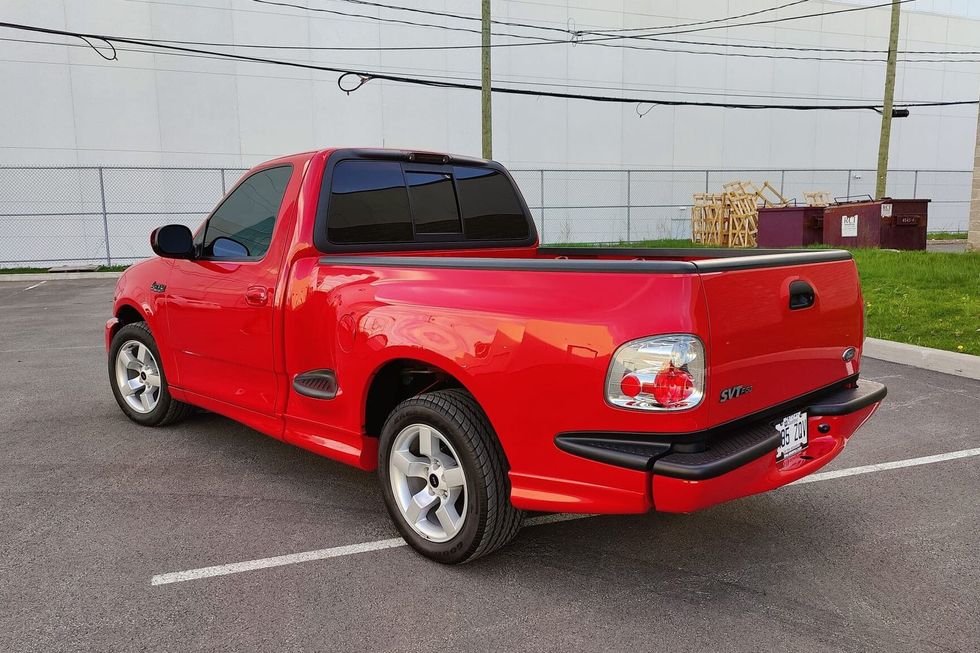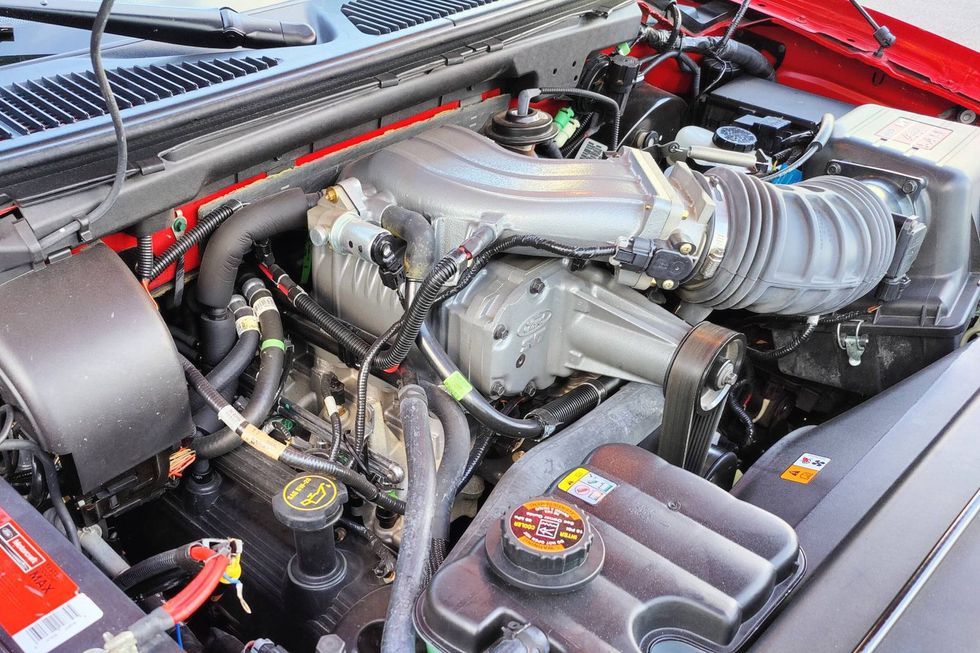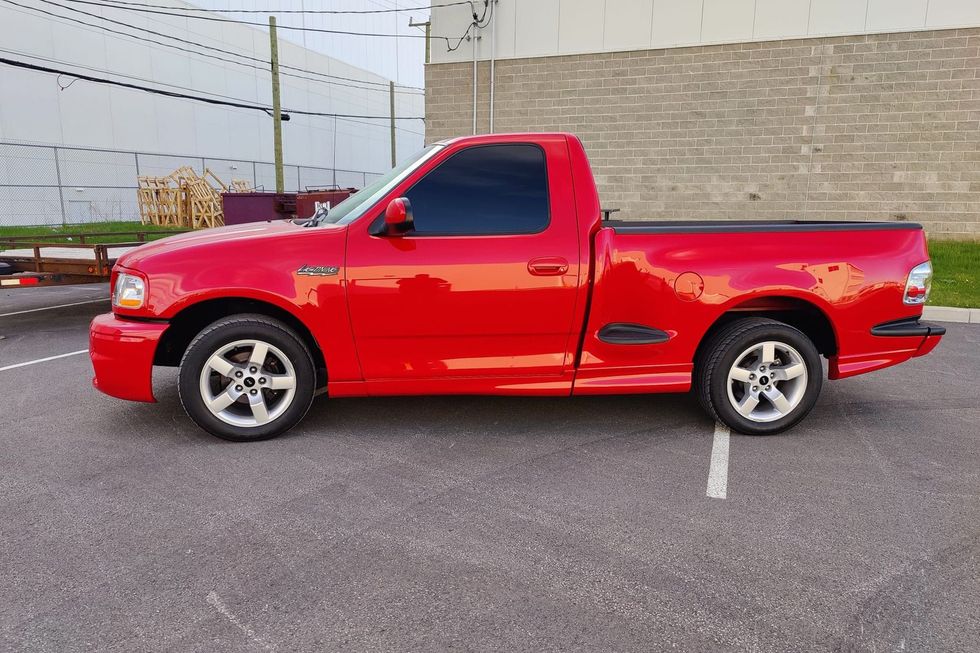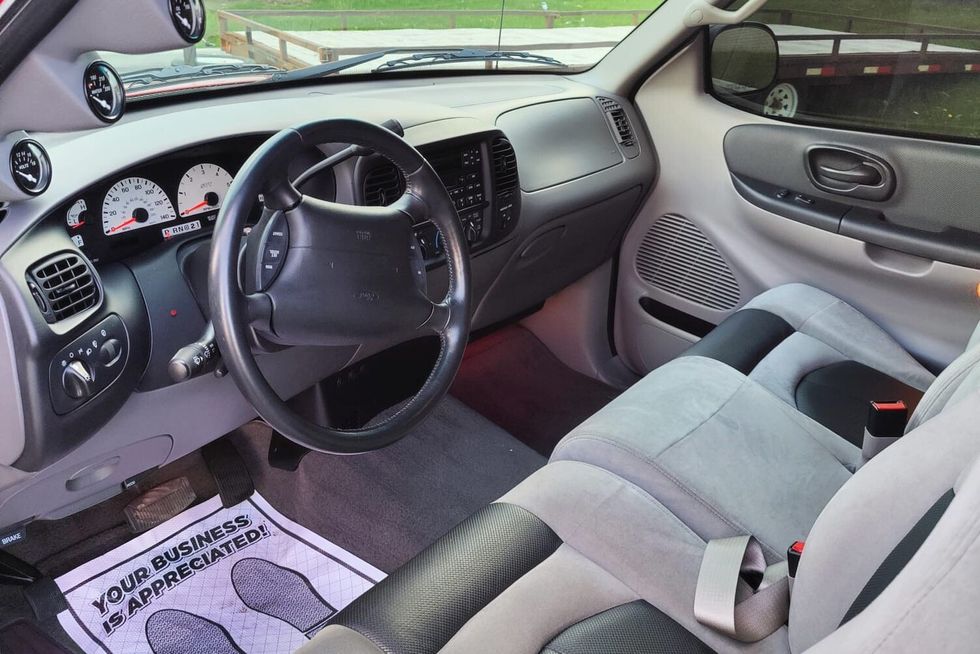This autocrossing, drag-racing 1989 Chevrolet Camaro RS is an ongoing father-daughter project
A horse of a different color
10/22/2021


If you're lucky enough to grow up as a car person in a car family, you’re lucky enough. That’s because car folks understand that, even when you’re young, the car you drive matters a lot. The average American spends an hour a day behind the wheel—and that, presumably, includes all the Americans who don’t drive at all—so being forced into something dull and practical can be quite excruciating.
Justina Schwartz, thankfully, was born to the right people. Her father, Jeff Schwartz, started Schwartz Performance, in Woodstock, Illinois, back in 2005. The company specializes in performance hardware for American muscle cars taking the “G-Machine” route. The “G” in G-Machine refers to gravitational forces, meaning the way you get pulled around when turning in a car built for handling.
Third-generation F-bodies, especially more quotidian models like Justina’s ’89 Camaro Rally Sport here, were certainly improved from a handling perspective compared with their predecessors, but 16 years on, by the time Jeff picked up this car for daily-driver duties, they left considerable room for improvement.
“I lost my job in 2004 and in 2005, I started my company,” Jeff recalls. “At the time, I was paying on a brand-new Mitsubishi Evo that I had.”
“The Evo,” Justina explains, “was ‘the cool new thing’ that had come to the U.S., finally, in the early 2000s.”
For budget purposes, though, the Evo had to go. Jeff found himself looking for something that was still cool but “cheap to drive every day and that wouldn’t break the bank on fixing it. Something you could buy brake pads from Autozone for $20.”
An internet search turned up this car, only 20 miles away in Elgin, Illinois. “It‘d had a cheesy repaint and somebody had put a backyard window-tint job on it. Other than that, it was a pretty solid car. I think when I got it, it had 89,000 or somewhere around there: not super-high miles. ”Jeff used the Camaro as simple transportation for a couple years while he built his business, then Justina’s older brother, Dale, needed a car.
“Dale was off at college in Kansas and my wife had given him an older Miata to drive. He yanked the engine and was going to do an LS swap on it over the Christmas break, but you know how that goes. It’s always a bigger job than you think. So, I ended up bringing the Camaro out to Kansas and giving it to him to drive for his last two years.”
It was while Dale was away at college that Justina and Jeff began to bond over cars.
“When my brother was away, I hung out with my dad more. That’s when I started doing more of the car stuff and got into it further.”
Dale put about 23,000 miles on the Camaro before returning it to Jeff. By that time, Justina was getting close to driving age, and, as she puts it, the Camaro “was just sitting around.”
“She said ‘Are you gonna build me a cool car like you did Dale?’ Dale had an ’82 Trans Am that we built together. I said, ‘Well, I didn’t build Dale his car, I helped him build a car. So, if you want to build a car, I’ll help you build a car as well.’”
Jeff and Justina agreed that the newly available Camaro was a good starting point, and they wasted no time getting started.
“That weekend I had her pull the seats out of it and we pulled the carpet and then we drove it out to the shop.” Come that summer, Justina pulled the original 305 V-8 and 700-R4 transmission. Unusually, however, there were no plans to replace the 170-hp L03 305 with an LS-series V-8. Instead, they would install a traditional small-block Chevrolet. That selection was driven by simplicity, cost consciousness, and convenience.
“I happened to have a 350 that was completely rebuilt that was in another project I bought and ended up doing an LS swap, so the small-block was essentially brand new and had never been used for anything.” There’s the convenience. That’s even simpler than going down to the junkyard and pulling an LS from a wrecked pickup.

As for cost, Jeff explains, “One reason we kept it a small-block is that there are a lot of hidden expenses with an LS swap—like the headers, serpentine drive, and so on. I call them ‘unintended’ or ‘unrecognized’ expenses. I was trying to keep it a little more low-buck.”
Contrast that with the simplicity of using a larger version of the original engine. “The factory serpentine setup and all of the exterior stuff bolted on from the 305,” Jeff says, though deviations were made where it was deemed better to upgrade. The factory throttle-body injection setup, for example, was discarded in favor of a Holley Sniper EFI atop an Edelbrock Victor Junior intake manifold. Jeff also advocated for a manual transmission swap, but Justina wasn’t yet comfortable driving a stick, so the original 700-R4 was rebuilt with a shift kit and upgraded clutches, then reinstalled along with a 2,200-rpm torque convertor.
Throughout, Justina did most of the work, under Jeff’s guidance.

“I showed her how to swap out the oil pan,” he says, “and had her put the intake manifold on. Along the way, I showed her how to torque the bolts and such. We went through the valve lash and adjusted it and everything. She put the engine and trans back in. I got suspension stuff and she ended up doing the installation of some of those items.” In the end, essentially only the paint and bodywork were farmed out to a friend of Jeff’s.
Fittingly for a hot rod, the Camaro was tweaked subtly in both body and hue.
“We did a hood and a rear spoiler from Hawks Third Gen,” Jeff says. “The hood is called a SUNOCO hood and the spoiler is taller than the original one. Both give the car a more aggressive look.
“We found a blue color that was very similar to the factory blue, but it was a Kia color called Santorini Blue—code HO. It was almost the same medium blue as the original but had a lot more depth to it. Modern colors have a little more depth and a little more pop and a little more metallic. After it got painted, we swapped out the suspension.”

The RS replaced the Sport Coupe as the base Camaro in 1989, after an appearance as a limited-production, California-only model in 1987. It boasted IROC-Z-inspired lower body panels, cast aluminum wheels (formerly used on the Z/28), quick-ratio steering, and sport suspension, but came standard with a 2.8-liter V-6, while a 5.0-liter V-8 was optional.
Since this Camaro was ordered with a 305 it could’ve shouldered a 350, but Jeff wanted to really overhaul the car’s chassis for superior braking and handling as well as to match the output of the new engine. “If you get a Z28 or a Trans Am or a Formula, they already have pretty good suspension on them. A set of tires is all you need, but the RS had smaller sway bars than the IROCs and the Z28s and such.”
The Schwartz family hobby is autocross. If you’re not familiar, that’s a racing discipline where a single car negotiates a twisting course of cones on pavement. Interestingly, that overlaps with Justina’s particular passion: horses.
“The first time she went to an autocross,” Jeff recalls, “I think it was the Car Craft Summer Nationals in Milwaukee, she said, ‘This is just like horse jumping, but in a car.’” “We have a discipline called ‘jumpers,’” Justina explains. “You have to be quickest within a certain time limit. Autocross is an adrenaline rush. My issue is wanting to be perfect.”
Speeds aren’t that high in autocross (the Sports Car Club of America says they top out around 55 or 60 mph), though power and gearing make for good acceleration. Vehicle control is paramount if you want to achieve a good time. It’s an excellent sport/hobby in which to use one’s daily driver, as the skills involve translate to vehicle handling on the road as well.
As with the engine, the suspension recipe was equal parts thrifty and inspired. Jeff explains, “I mini tubbed it and then I made a coilover setup for it. I bought some Viking coilovers and fabricated my own brackets. I did the coilover setup first because then that gave me room to mini tub it.
“On the front, I bought off-the-shelf QA1 coilovers. At the time I did this—a number of years ago—there wasn’t a lot of stuff available [for third-gen F-bodies] like there is now. It has a pair of Hotchkis sway bars I won at the Motor State Challenge event.
“With the coilovers, you’ve got adjustable damping and it’s pretty solid. It’s a pretty good-handling car.”
A Moser-built Ford 9-inch with 3.70 gears and a limited-slip differential was swapped in during the suspension reconfiguration. Fourteen-inch Baer brakes were fitted front and rear behind 18-inch Weld wheels: 18 x 9s on the front, shod with 235/35R18 tires and 18 x 12s out back, wearing 315/30R18s. BFGoodrich tires were used on all four corners.
All told, the Camaro project took two years.
“When we started the build,” Justina says, “I was 15. We finished it when I was 17 and we debuted it at the Chicago Auto Show at McCormick Place with the Illinois Camaro Club.” It’s no show car, though. It gets driven on the street, albeit carefully, and Justina’s interest in the car has grown over time.
“I did drive it to high school a couple times and everybody’s jaw dropped, but I didn’t really drive it all the time. I didn’t want anything to happen to it. Then I started autocrossing it in the spring of 2015, up in Milwaukee, Wisconsin, with the SCCA. I’ve done that more times than I can count. I probably have done at least 15 to 20 events with it.”
Now 23, Justina finds herself looking forward to using the Camaro more in the future, especially as an autocrosser, and she’s on the same page as Jeff when it comes to a potential manual transmission swap.
“I think in the future, I’d like to put a five-speed in it. I’d ideally like a T-56 [six-speed], but Dad’s big on a five-speed. I guess we’ll see.”

Block type: Chevrolet “small-block” cast-iron OHV V-8
Cylinder heads: World Products cast iron
Displacement: 355-cu.in.
Bore x stroke: 4.030 x 3.48 in
Compression ratio: 9.5:1
Pistons: Keith Black cast aluminum
Connecting rods: GM steel
Crankshaft: GM cast steel
Horsepower @ rpm: 440 @ 6,150
Torque @ rpm: 460 lb-ft @ 4,450
Camshaft type: COMP Cams hydraulic
Duration: 230/236 degrees duration
Valvetrain: 2.05/1.80-in valves; COMP Cams hydraulic lifters
Induction system: Edelbrock Victor Jr. aluminum intake; Holley Sniper EFI
Lubrication system: Stock Chevrolet gear-type pump
Ignition system: Holley Dual Sync distributor
Exhaust: SLP headers, stainless 3-in dual exhaust with Magnaflow mufflers
Original engine: Chevrolet 305-cu.in. V-8
Type: GM TH700-R4 four-speed automatic
Ratios: 1st/3.06:1 … 2nd/1.63:1 … 3rd/1:1 … 4th/0.7:1 … Reverse/2.9:1
Type: Moser Ford 9-inch with limited-slip differential
Ratio: 3.70:1
Type: Recirculating ball with power assist
Turns, lock-to-lock: 12.7:1
Type: Baer four-wheel disc, six-piston calipers
Front/Rear: 14-in cross-drilled and slotted rotors
Front: Independent; QA1 adjustable coilover shocks, Hotchkis SP 27-mm anti-sway bar
Rear: Live axle with owner-built coilover conversion; Viking coilovers, Hotchkis SP 22-mm anti-sway bar
Wheels: Weld
Front: 18 x 9 in
Rear: 18 x 12 in
Tires: BFGoodrich g-Force Rival
Front: 275/35R18
Rear: 315/30R18
1⁄4-mile ET: 13.34 sec @ 109 mph
Top speed: 165 mph
Forget Ford’s groundbreaking electric truck for a moment to consider this 2001 Ford SVT F-150 Lightning now offered on Hemmings Auctions. Instead of the dual permanent-magnet motors found in the current electric Lightning, the 1999-2004 SVT Lightning featured a supercharged version of Ford’s 5.4-liter “modular” OHC V8. Rated at 380 horsepower in the 2001-’04 models, it was good enough to make a stock lightning a formidable opponent on the street as well as at the strip.
A follow-up to the original 1993-’95 F-150 Lightning, which was a high-performance version of a standard F-150, the second-generation SVT super truck presented as a more thoroughly developed model with a lot more exclusive components that further differentiated it from the rest of the F-Series lineup. Beyond the engine, the entire suspension and braking system, not to mention aerodynamic body add-ons, were part of the Lightning package from 1999 through 2004. Exclusive interior components were also part of the package.
At the heart of this SVT Lightning is its iron-block 5.4-liter SOHC, 16-valve V8 with a supercharger and an intercooler. The blower helped it deliver 380 horsepower and 450 lb-ft of torque in 2001, up some 20 horsepower and 10 lb-ft from the ’99 and 2000 models. The Eaton supercharged engine delivered peak boost of 8.0 psi and the engine featured an 8.4:1 static compression ratio, down from the standard 5.4 V8’s 9.0:1, which was rated at 260 horsepower and 350 lb-ft.
Power reached the rear 18-inch cast aluminum-alloy wheels via a four-speed automatic, an aluminum driveshaft and a beefy 9.75-inch, limited-slip rear axle with an acceleration-friendly 3.73:1 final-drive ratio, another upgrade for 2001. Car and Driver magazine reported a 0-60 mph time of 5.2 seconds and a quarter-mile in an E.T. of 13.8 seconds at 104 mph—impressive numbers for a 4,600-pound truck. Top speed was a drag-limited 142 mph.

Trucks generally require a suspension that can handle a full load in its bed while also providing competent driving while empty. But if you fancy one designed to a sports-car standard, then something has to give. In the case of the second-gen Lightning, Ford dropped its payload capacity to a mere 800 pounds. A standard 2001 F-150 Styleside carried a 3,180-pound payload rating, while an F-150 Flareside was rated at 2,005 pounds, some two-and-a-half times the Lightning, which featured the short-bed Flareside body. Towing capacity, likewise, was reduced from 8,800 pounds to 5,000 in the Lightning. But the Lightning’s strengths were never its payload or towing capacities, but it’s ability to perform like a sports car.
As a 21st century performance vehicle, however, the second-gen Lightning was also equipped to handle. A half-inch drop at the front was accompanied by SVT-specific coil springs and Bilstein shocks along with an exclusive 31-mm solid anti-roll bar. SVT’s influence continued at the rear with Lightning-specific five-leaf springs and a 23-mm solid anti-roll bar. The Bilstein setup at the rear included the right-rear shock staggered toward the front of the truck to reduce axle hop under heavy acceleration. The four-wheel antilock disc brakes were cribbed from the three-quarter-ton F-250, with 12.1-inch front rotors at the front and 13.1-inch discs at the rear.

As the years go on, fewer and fewer clean, unmolested low-mileage examples are out there, which is why this 2001 Ford SVT F150 Lightning now on Hemmings Auctions caught our attention. Showing just 5,525.5 miles on its odometer at the time of submission, it is said to be in “mint” condition and have an “immaculate” finish in the seller’s words. No modifications are noted to any part of the vehicle. The 18-inch factory alloys don’t appear to have any curb rash, though the Goodyear performance tires may be original. About the only deviations from stock are the tinted windows.
The latest electric-only F-150 Lightning is certainly a quick vehicle in its own right, but this 2001 edition from the engineers at SVT was built for excitement, not range. It was made with an old-school muscle-car vibe along with modern handling and braking. Which Lightning would you look good behind the wheel of?
Take a look at this second-gen Lightning on Hemmings Auctions before the bidding ends.

Tim Kuniskis, longtime Stellantis executive and a prominent voice in the modern-day American muscle car era, is retiring after 32 years with the company. Kuniskis, also known as the godfather of the Hellcat V8, was appointed Brand Chief Executive Officer (CEO) of Dodge and a member of Stellantis' Top Executive Team in January 2021. He took charge of Ram in July of 2023. His retirement begins on June 1st of this year.
With Kuniskis leading the way, the Dodge brand embraced its American muscle car image, further building a passionate fan base for its high-performance vehicles, including the Charger, Challenger, and the Viper, by introducing the “Brotherhood of Muscle.” We saw the return of Dodge’s Direct Connection subbrand, which makes tuning products more accessible to its enthusiasts.
Kuniskis was there through Dodge’s Last Call campaign, the brand’s final send off for two of its iconic V8-powered muscle cars, the Dodge Challenger and Charger models, before turning the page to the next generation. Dodge’s Last Call models included the 2023 Dodge Challenger R/T Scat Pack Shakedown, 2023 Dodge Charger Super Bee, 2023 Dodge Challenger R/T Scat Pack Swinger, 2023 Dodge Charger R/T Scat Pack Swinger, 2023 Dodge Charger King Daytona, 2023 Dodge Challenger Black Ghost, and the 2023 Dodge Challenger Demon 170. He also oversaw the next generation muscle car’s reveal, which confirmed the offering of an all-electric powertrain, plus he played a key role in the reveal of the all-electric 2025 Ram.
“I want to take the opportunity to warmly thank Tim for his passion, commitment and contributions to Stellantis and in defining the vision of the future electrified Ram and Dodge brands,” said Stellantis CEO, Carlos Tavares. “I wish him well in his retirement.”
Tim Kuniskis’s retirement comes at a challenging time for the company. Dodge has seen a drop in sales since the phase out of the previous Challenger and Charger models. Sales were down by 16-percent for the Charger coupe and sedan in Q1, while at the same time, Ram sales reportedly dropped by 26-percent. Vehicle shipments worldwide were down 10-percent (to 1.3 million) compared to the same three-month period a year ago. Stellantis revenue declined by a total of 15% to $20.7 billion.
Stepping up to the company’s future challenges in Kuniskis’s place is Matt McAlear, the new CEO of Dodge, who led Dodge's sales operations in the recent past. Christine Feuell, prior Chrysler CEO who had a hand in the reveal of the Halcyon Concept earlier this year, will now be in charge of the Ram brand.

Christine Feuell
Stellantis

Matt McAlear
Stellantis
“I am confident that Chris will continue the work of Tim in leading the iconic Ram brand,” said Tavares. “Matt will bring a fresh perspective, while continuing to draw on the heritage of our iconic Dodge brand and leading the transition of the brand toward a sustainable future.”